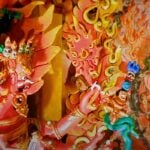Mother Tara’s many-armed protective embrace: 21 Taras according to Surya Gupta — with 8 videos and mantras and stunning art
There’s something very precious and special about Tara, the protective Mother, adored by millions around the world. Her energy is, at its root, wisdom — the female Enlightened Buddha.
Tara is as approachable as our own mothers. She embodies the same protective traits, but not just protector: like a mother, she is teacher (usually our mothers teach us our first words), fierce motivator (taking out the garbage and chores), nurturer (always patient with us as we grow and learn.) Like a mother she never judges us: her practice assures us both temporal benefits (helping us in our mundane, daily lives) and profound ultimate benefits — the path to realizations and Buddhahood.
Special Feature: Includes 7 Videos of the individual Taras with Her Mantra chanted by Yoko Dharma! Plus a Video of the 21 Praises to Tara according to Surya Gupta. Each Tara is illustrated with two styles of art: A traditional style by Niels Petersen (Videos 3,4,5,7) and a modern style by the master artist V.V.Sapar (video 6 and in these feature images). Beautiful art from Angeli Lhadripa Shkonda in videos 1 and 2.
Tara, like our own mothers, doesn’t judge us. And, like our mothers, she can wear many faces (sometimes the stern disciplinarian, other times, the embracing mother). In this way the 21 Taras visualization, based on the Mahasiddha Surya Gupta, is very special. Each of the 21 Taras has a unique name and praise, mantra, and sadhana, with deeply profound symbolism, attributes and practices.
“Tara is without a doubt the most beloved female deity in Tibetan Buddhism, revered for her swiftness in helping those who rely on her. She has been described as a Buddha for our modern age, a sublime personification of compassion and wisdom in female form at a time when sorrow and suffering seem to be increasing everywhere. Of all the Buddhas, Tara is the most accessible.” — H.E. Venerable Zasep Tulku Rinpoche, from Tara in the Palm of Your Hand. [1]
- For Part 2 in this series see>>
- For Part 3 in this series see>>
- For Surya Gupta Art feature and interview with artists Angeli Lhadripa Shkonda on Buddha Weekly, see>>
- For a feature interview with master artist V.V. Sapar in Buddha Weekly, see>>
The wondrous Surya Gupta 21 Taras
In this feature, we cover the 21 Taras according to the Mahasiddha Surya Gupta’s rich system, where each of the 21 Taras has a unique name and praise, with deeply profound symbolism, attributes, and practices.
A beautifully chanted PRAISE TO 21 TARAS ACCORDING TO SURYA GUPTA produced by Buddha Weekly as a video, with art from VV Sapar and Ben Christian:
[To get a sense of this wondrous system, scroll down the page and view the many individual Tara images. IN PART 1 of this series, we cover the first seven Surya Gupta system Taras. Here is PART 2 for the next seven>>.]
[NOTE: Individual Tara images illustrated here are by the illustrious artist V.V. Sapar [See our feature interview with V.V. Sapar here>>] commissioned and directed by Dzongsar Khyentse Rinpoche. Dzongsar Khyentse Rinpoche, out of generosity, makes these wonderful high resolution images available for free download on the Khyentse Foundation website>>]
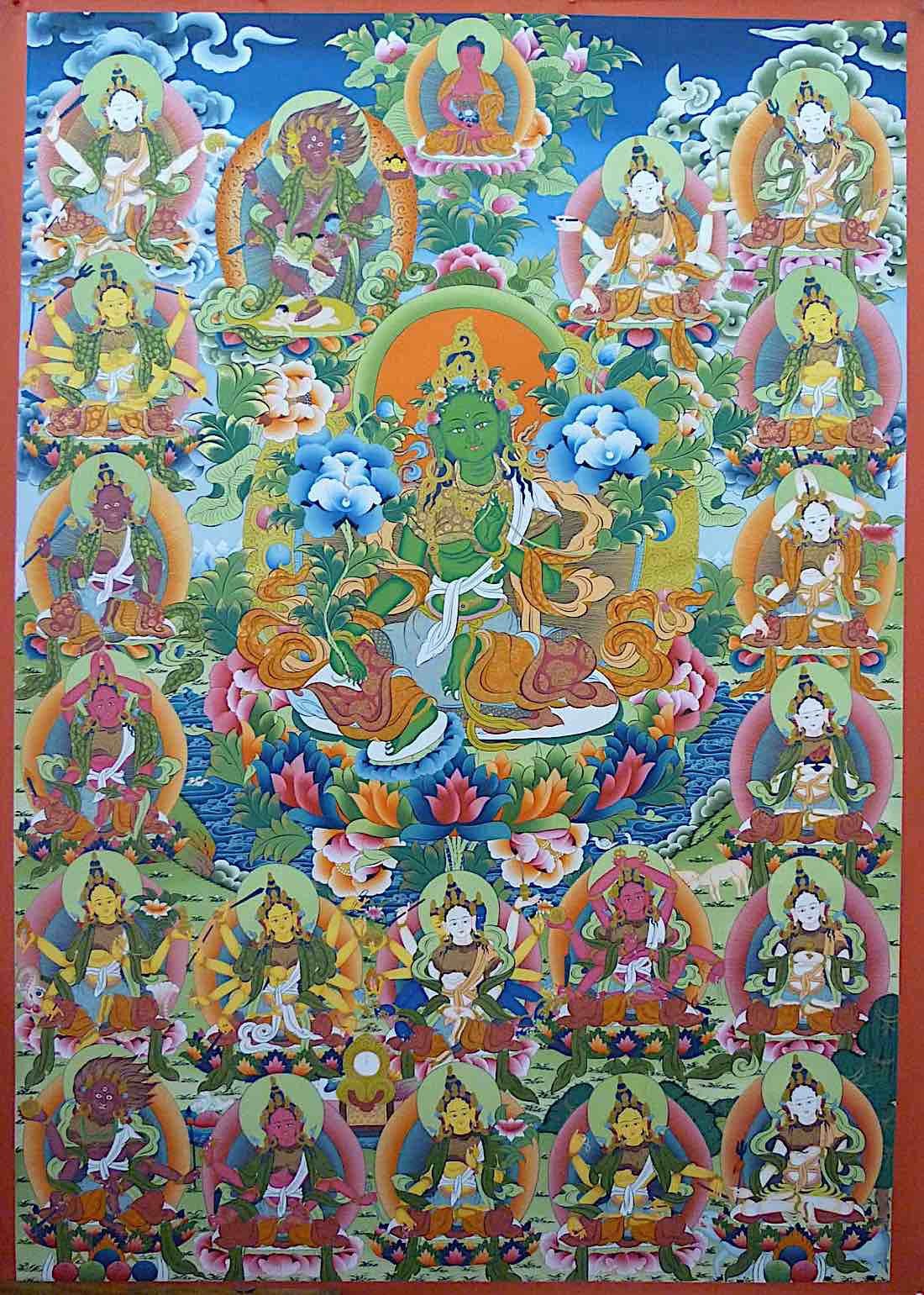
Starting the day right: with Praise to the 21 Taras
Before their first cup of tea (or coffee, in the west), millions of people around the world start their day with the Praises to the 21 Taras. [Full text of the praises in English and Tibetan below.] Tara is the embodiment of motherly protection, an ideal way to start the day, nostalgically reminding us of our childhood mothers sending us off to school.
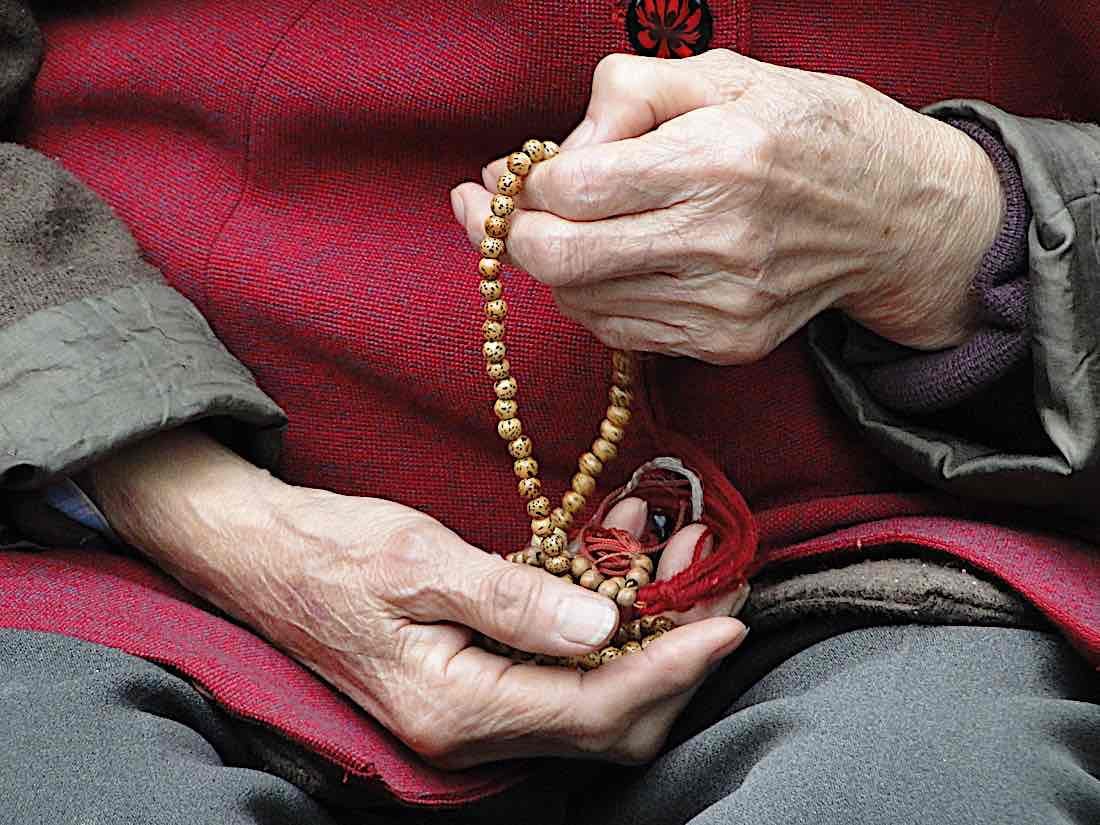 The flavour and approachability of Tara practice is expressed beautifully by Venerable Zasep Rinpoche:
The flavour and approachability of Tara practice is expressed beautifully by Venerable Zasep Rinpoche:
“Every night, my grandmother recited the mantras of Tara and the other Buddhas until she fell asleep. In the yurt was a small altar on which there were statues of Tara and other Buddhas; a butter lamp on the altar flickered comfortingly. When I would wake up during the night, I would see the statues illuminated by the soft light of the butter lamp; I would feel so protected by Tara, the other Buddhas, and my grandmother’s prayers.” [3]
Chanted in many languages, but especially rythmic and beautiful in Tibetan — where each Tara’s praise is chanted in four lines of eight syllables each — the main differences in practice are in the visualizations of the Taras. Yet, the 21 Taras can be much more than a beautiful praise to start out day. The Surya Gupta tradition, especially — where each of the 21 Taras is distinctly different — is a profound practice, with Sadhanas and Mantras for each of the Taras.
There are at least four 21 Tara traditions, although the two best known are the 21 Taras according to Atisha tradition, and the earlier — but more complex — 21 Taras according to the great Mahasiddha Surya Gupta. Visualizing and practicing in the Atisha tradition is certainly easier, with the main variant being color and some expressions. No empowerment is required. Practice is very simplified.
NOTE ON THE 9th TARA in Surya Gupta
You will see some Thangkas and systems of Surya Gupta lineage with different Taras for Tara 9. This slight difference tends to be along the lines of school-tradition, with Khadiravani Tara (as presented here) in the majority of the Gelug Tradition and the Varada Tara (red) in the Jonang tradition and certain special teaching lineages. This is according to Robert Beer (referring to the thangka below this description):
“9. Khadiravani Tara (Tib. seng-lden-nags-kyi sgrol-ma)
In the Suryagupta tradition Khadiravani Tara frequently occurs as the ninth of the twenty-one Taras, although Varada Tara (described below) may also occupy this ninth position. In this particular thangka the main central figure of Green Tara as Khadiravani Tara appears as the ninth of the twenty-one Taras. The Sanskrit term khadiravani refers to a grove (vana) of fragrant acacia (khadira) trees, and this form of Green Tara is usually depicted with her two attendant deities, peaceful yellow Marici to her right, and fierce blue-black Ekajata to her left. Here Khadiravani Tara is depicted in the traditional form and posture of Green Tara, with the golden disc of the sun forming her backrest and with her two hands holding the stems of blue utpala lotuses.
Varada Tara (Tib. mchog-stsol-ba’i sgrol-ma)
Although she is not actually depicted in this thangka, Varada Tara, the “Tara Who Grants Boons”, is the ninth of the twenty-one Taras, and she is described as follows:
Varada Tara sits in vajra-paryanka or sattva-paryanka posture upon a white moon disc and a red lotus. She is peaceful and red in colour, with one face, two eyes, and four arms, and adorned with the divine silk and jewel ornaments. Like Pravira Tara (1), the first of the twenty-one Taras, she holds a vajra and bell with her first pair of right and left hands joined above her crown in the gesture of ‘Great Bliss’. With her extended second right hand she makes the mudra known as ‘Snapping the fingers in the gesture of dance’. With her second left hand she holds a fruit-bearing branch of an ashoka tree, from the leaves of which fall a ‘rain of jewels’ that satisfy the desires of all beings. She is crowned with green Amoghasiddhi Buddha, and her main function concerns rituals of consecration.”
Why practice 21 aspects of Tara?
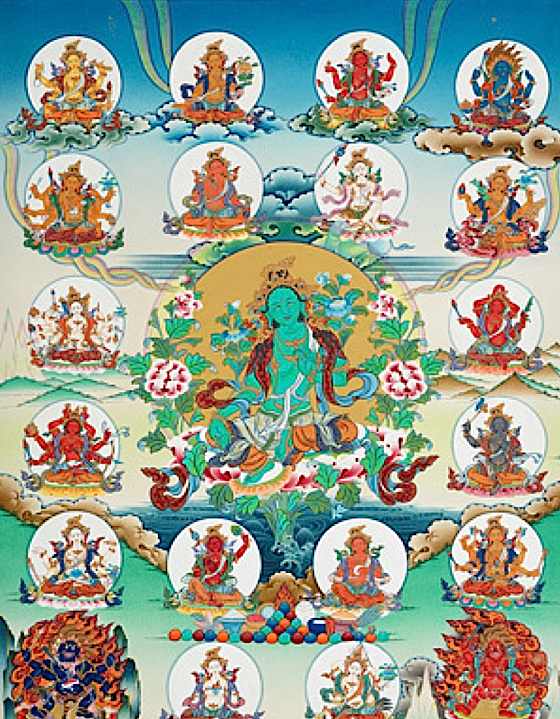
There are many aspects of Tara, including profound emanations “like Vajrayogini, Kurukulle, Machig Labdron, and Palden Lhamo…” H.E. Zasep Rinpoche explains why we honour different aspects:
“This is similar to one person performing many roles, such as being a musician, an athlete, a mother and a wife, and having different personal characteristics such as being artistic, kind, humorous, and clever. While they vary in the details of their appearance and their activity, all the Taras have in common the energy, compassion, and wisdom to free sentient beings beyond number from their suffering.” [1]
According to Mahasiddha Surya Gupta’s practice, “each of the twenty-one Taras holds different implements. They may also assume different postures, some sitting, some standing, and may have more than one head and several pairs of arms.”
Rinpoche also answer a question often asked by students: “The twenty-one praises may be recited in Tibetan, English or any other language. It does not matter. Languages have no inherent existence; no one language is inherently superior to any other.” [1]
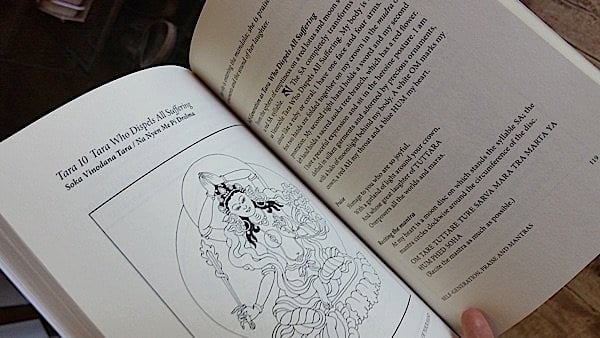
21 Taras according to Surya Gupta is a profound practice
The earlier practices of Surya Gupta’s 21 Taras is considered more profound, not just be virtue of complexity, but on the strength of deeply meaningful symbolism. The same 21 Taras transform into many forms, with numerous attributes. As with other deities, she can be wrathful, semi-wrathful, peaceful.
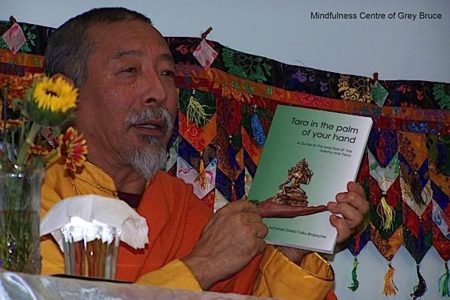
Zasep Rinpoche described the practice as “more advanced… like a higher Tantra”, although it is actually a Kriya Trantra, approachable to all:
“The Mahasiddha Surya Gupta lineage of the twenty-one Taras is quite different from the Atisha lineage in that each of the twenty-one Taras is very distinctive in appearance and attributes and each Tara has her own sadhana. Although technically the practice of the twenty-one Taras is Kriya Tantra, it feels more advanced, with the sadhanas reading more like sadhanas from a higher level Tantra. Of course, in a sense, our experience of any Tara sadhana practice depends on the state of our mind and our degree of realization.” [4]
Mahasidda Surya Gupta
According to Thomas Roth: “According to Tāranātha, Sūrya-Gupta was born in present day Kashmir. A Mahāsiddha who practiced and accomplished Tārā for seven consecutive lifetimes, he was a contemporary of such masters as Śantideva, Candrakīrti, and Candragomin, another important master in the various transmission lineages of the Tārā tantras and practices.” [5]
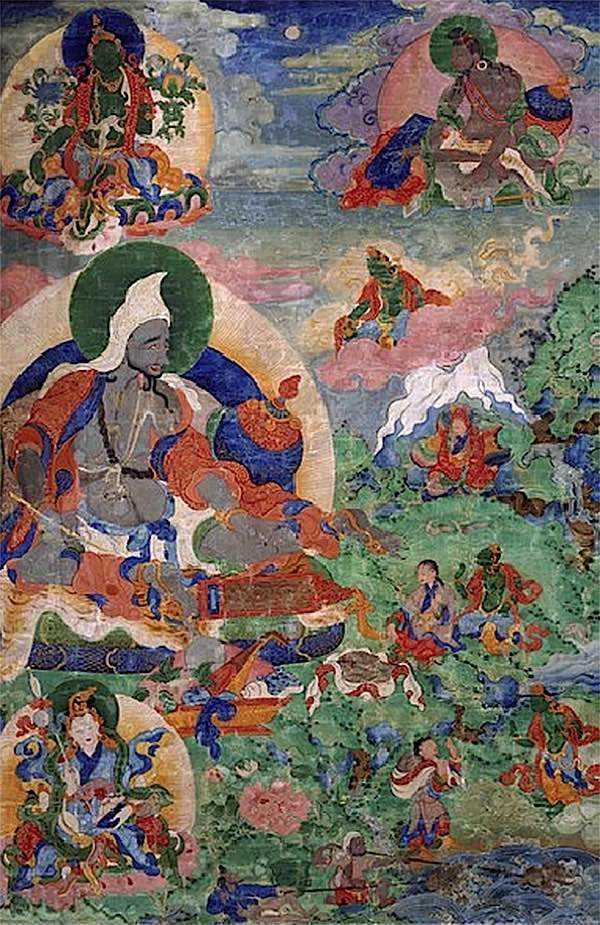
Suryagupta, one of the great Eighty-four Mahasiddas (7th/8th century) had countless visions of glorious Mother Tara. She so cherished the great master — also known as Ravigupta or “Nyi ma be pa” in Tibetan — that she first cured him of leprosy. (As recorded by the Indian scholar Vajrasana of Bodhgaya in the 11th century). [1]
Interestingly, even though Tara instantly cured him of Leprosy, she left one tiny sore on his forehead. When he asked her why, she replied:
“Formerly you were born as a hunter, killed animals and in the end set fire to a forest. In consequence of this, you were reborn in Hell and this is your last rebirth of the 500 rebirths in Hell, and saying so, she bestowed on him the sadhana, accompanied by a stotra. The Tara said with their help, one may perform any kind of magic rite. I shall grant you miraculous powers (siddhi).” [1]
What’s in a praise and a name: everything, and nothing
Her name carries resounding power in our mindstreams on one level. Ultimately, like all names, it is an empty label.
Her name translates from the Tibetan as “Venerable Tara, Supreme Mother, the Liberator” from the praise to Tara:
OM.je.tsun.ma.pag.ma.drol.ma.la.chag.tsal.lo
- Je — “Je means venerable protector, so Tara is the most precious protector of all sentient beings.” [2]
- Tsun.ma — “In colloquial Tibetan, tsun.ma means nun and indicates a woman who has pure morality.” [2]
- Pag — translates as “Supreme”
- Ma — means “Mother”
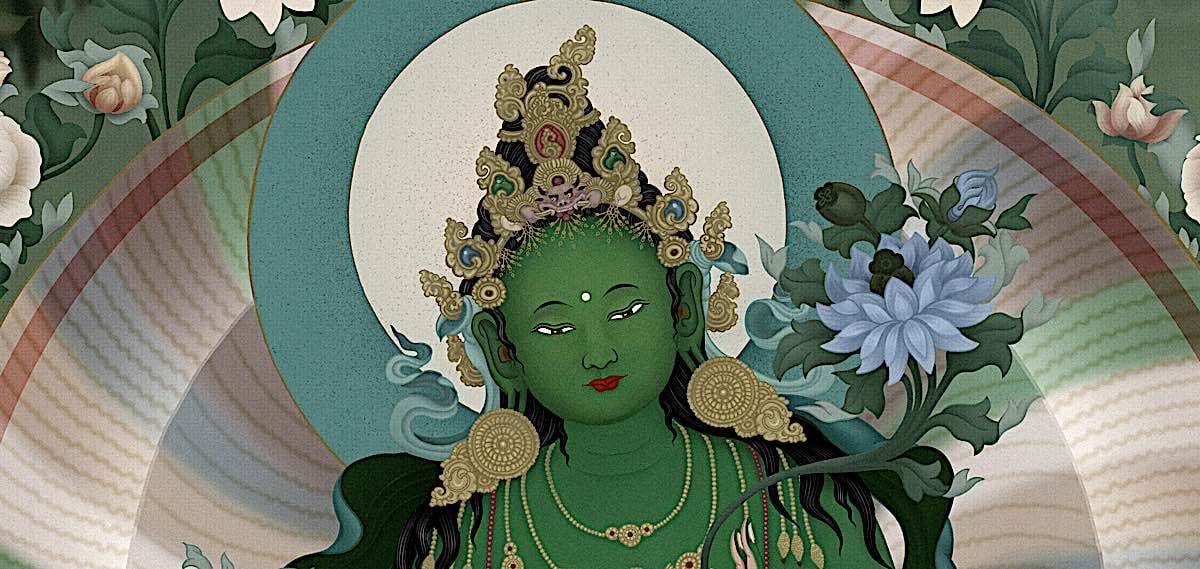
Tara’s Main Name Praise
OM.je.tsun.ma.pag.ma.drol.ma.la.chag.tsal.lo
OM, Homage to Venerable
Tara, the Liberator
21 Taras according to Surya Gupta
The practice of 21 Taras according to the great Mahasiddha Surya Gupta, requires intense visualization. The praises are the same as in the later Atisha system. As with all 21 Tara practices, the devotee can simply chant the praise each morning and let the faith grow over time as Tara helps us day-to-day.
The real practice is properly taught by a teacher or in Tantras, mostly in Tibetan. Some pratitioners choose to do a Tara Sadhana a day for 21 days. On retreat, of course, all 21 sadhanas would be performed. For a specific need, for example, for help with infectious disease (Hint: Tara 2), the Sadhana of the most aligned aspect of Tara might be performed.
Clearly, it is a more involved practice of Tara, since each aspect, in the Surya Gupta method has:
- Her own self-generation (or front generation if you don’t have empowerment)
- Her own rite and powers (aspect or specialty)
- Her own Sadhana
- Her own special mantra (video of mantra chanting and image for each Tara is below) anyone may chant Tara mantras, even without empowerment, however it is considered more effective and profound if you have “lung” transmission of the mantra.
- Her own appearance and attributes
- Only the praise and name of the 21 Taras is comparable betwen the Atisha method more commonly practiced, and the older Surya Gupta tradition.
Here, in this feature, there is only space for a brief description and praise, and we’ll include some images to give you a sense of this wonderful and powerful practice.
The only book with full English sadhanas and mantras and modern-day illustrations of the Taras is the wonderful book by H.E. Zasep Rinpoche, Tara in the Palm of Your Hand. [For a book review, please see here>>]
Note: For names, we’ve numbered with English translation, per Tara in the Palm of Your Hand. Below that are the Sanskrit name followed by the Tibetan name.
Tara 1 Heroic Red Tara
Pravita Tara / Rabtupa We Drolma
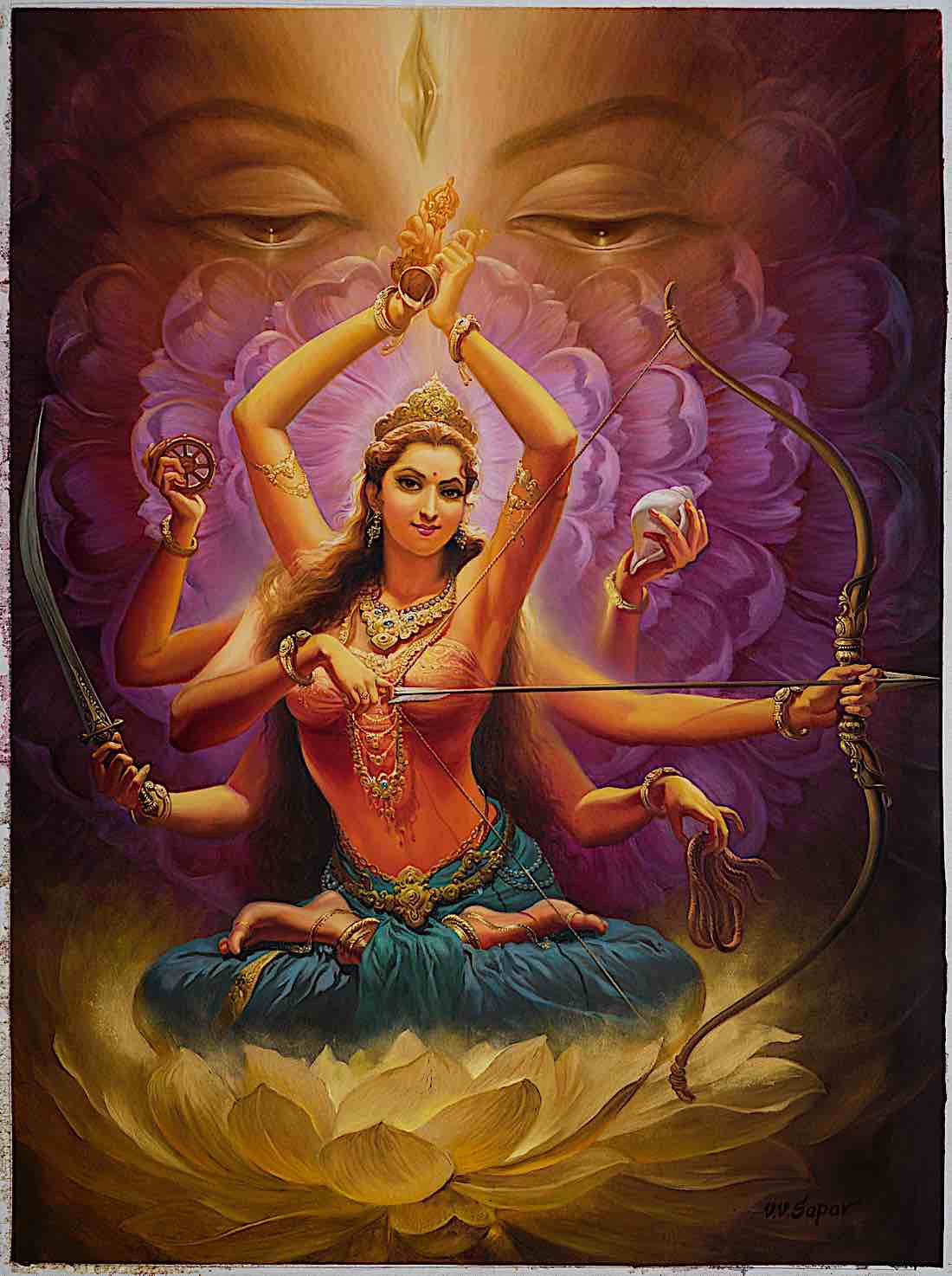
Attributes of Heroic Red Tara
- Power or Rite: turning back the power of others.
- Seed syllable OM
- Colour: red
- Number of arms: four
- Peaceful or wrathful: peaceful
Mantra of Heroic Red Tara
OM TARE TUTTARE TURE SARVA TRE DATU VASHAM KURU SOHA
For pronunciation, or to chant along, play the embedded video below.
Video of Heroic Red Tara visualized with Tara’s first mantra chanted by Yoko Dharma:
Praise to Heroic Red Tara
Homage to you, the Swift One, the Heroine,
Whose eyes are like an instant flash of lightning,
Who arose from the open corolla
Of the lotus face of the Lord of the Three Worlds.
Tara 2 Moonlight White Tara
Chandra Kanti Tara / Karmo a Dang Ge Drolma
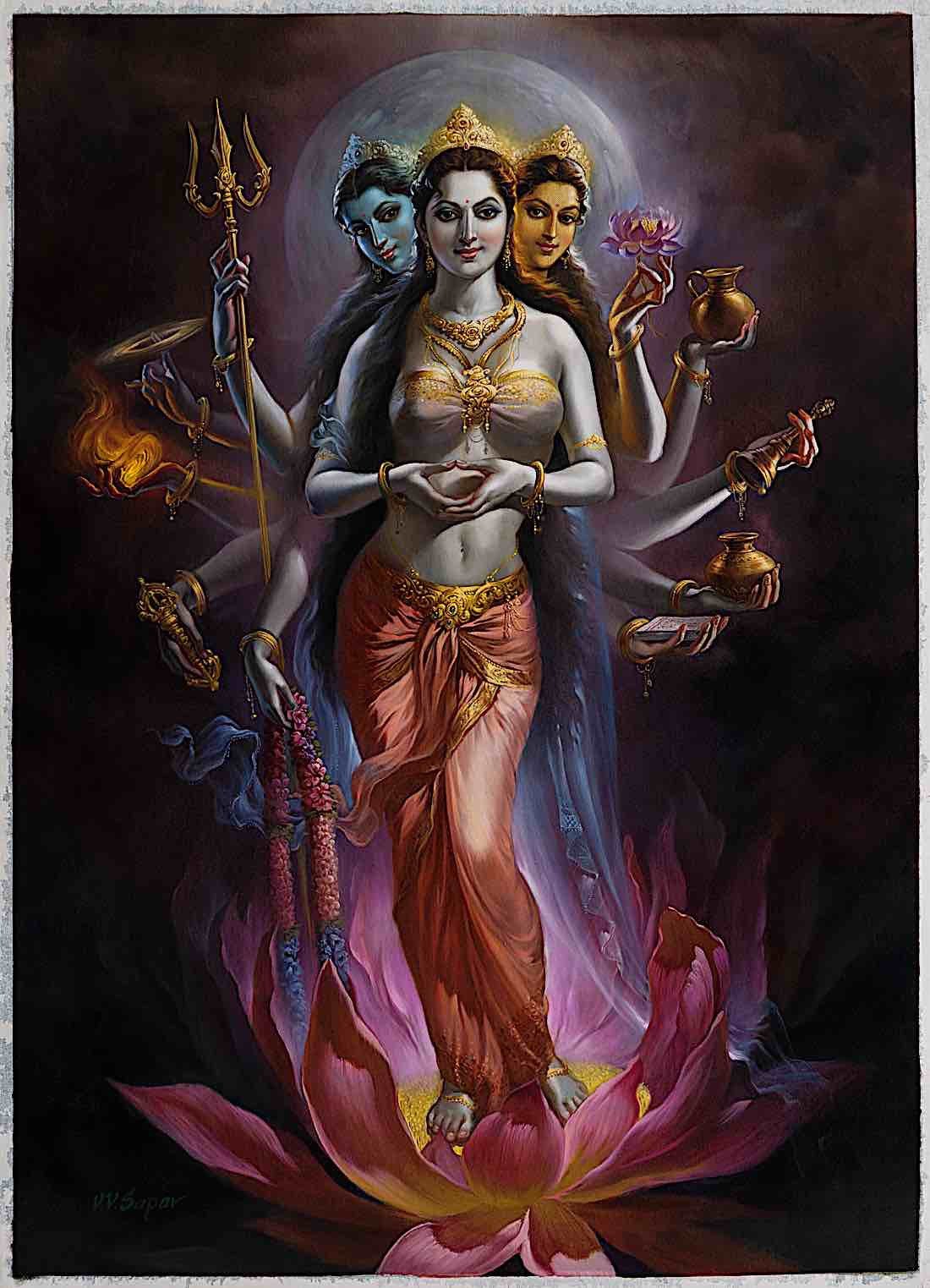
Attributes of Moonlight White Tara
- Power or Rite: calming infectious disease.
- Seed syllable TAM
- Colour: white
- Number of arms: twelve
- Peaceful or wrathful: peaceful
Mantra of Moonlight White Tara
OM TARE TUTTARE TURE SARVA PAPAM SHIN TEM KURU SOHA
For pronunciation, or to chant along, play the embedded video below.
Video of Moonlight White Tara visualized with Tara’s first mantra chanted by Yoko Dharma:
Praise to Moonlight White Tara
Homage to you whose face is like one hundred autumn moons
Completely full, and gathered into one,
Radiating a great and distinguished light,
Superior to the gathering of a thousand stars.
Tara 3 Golden Color Tara
Kanaka Vana Tara / Ser Mo Serdok Chen Ge Drolma

Attributes of Golden Color Tara
- Power or Rite: prolonging life.
- Seed syllable RE
- Colour: golden (bluish)
- Number of arms: ten
- Peaceful or wrathful: peaceful
Mantra of Golden Color Tara
OM TARE TUTTARE TURE SARVA AYU PUNYE PUSH TEM KURU SOHA
For pronunciation, or to chant along, play the embedded video below.
Video of Golden Color Tara visualized with Tara’s first mantra chanted by Yoko Dharma:
Praise of Golden Color Tara
Homage to you who are golden blue,
Whose hands are beautifully decorated with a water-born lotus;
Who embody the Six Perfections of giving, moral discipline,
Patience, perseverance, concentration, and wisdom.
Tara 4 Golden Tara of Crown Victorious
Usnisa Vijaya Tara / Tsug Tor Nam Pal Gyal We Drolma
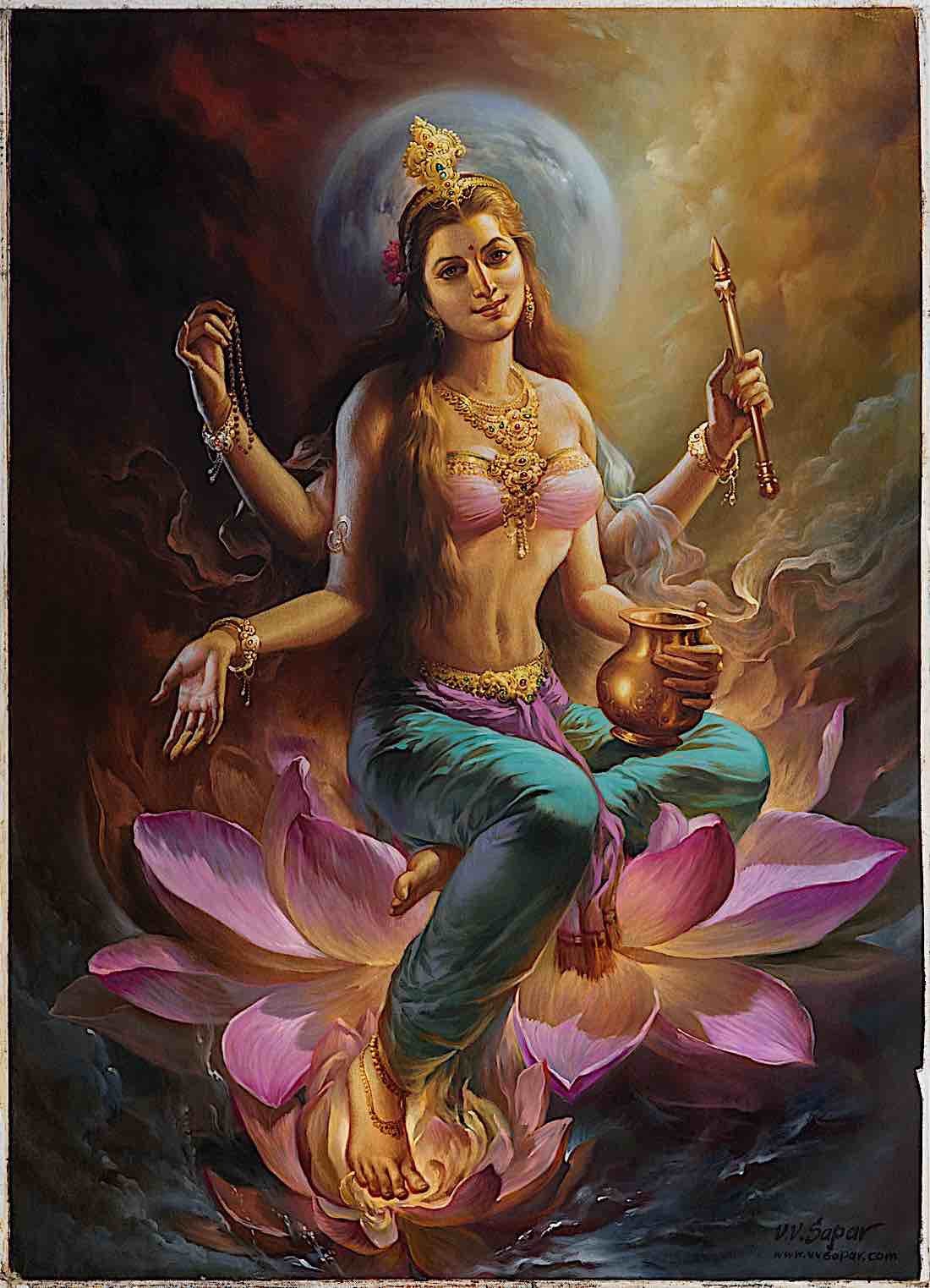
Attributes Golden Tara of Crown Victorious
- Power or Rite: neutralizing lethal poisons.
- Seed syllable TUTA
- Colour: golden
- Number of arms: four
- Peaceful or wrathful: peaceful
Mantra of Golden Tara of Crown Victorious
OM TARE TUTTARE TURE SARVA AYU GHANA PUSH TEM KURU SVAHA
For pronunciation, or to chant along, play the embedded video below.
Video of Golden Tara of Crown Victorious visualized with Tara’s first mantra chanted by Yoko Dharma:
Praise to Golden Colour Tara
Homage to you, who crown the Buddhas’ ushnishas,
Whose victorious actions are without limit,
Who have attained all transcendental wisdoms without exception,
And on whom the Bodhisattvas themselves rely.
Tara 5 Tara Proclaiming the Sound of HUM
Hum Svara Nadini Tara / HUM Dra Dolpi Drolma
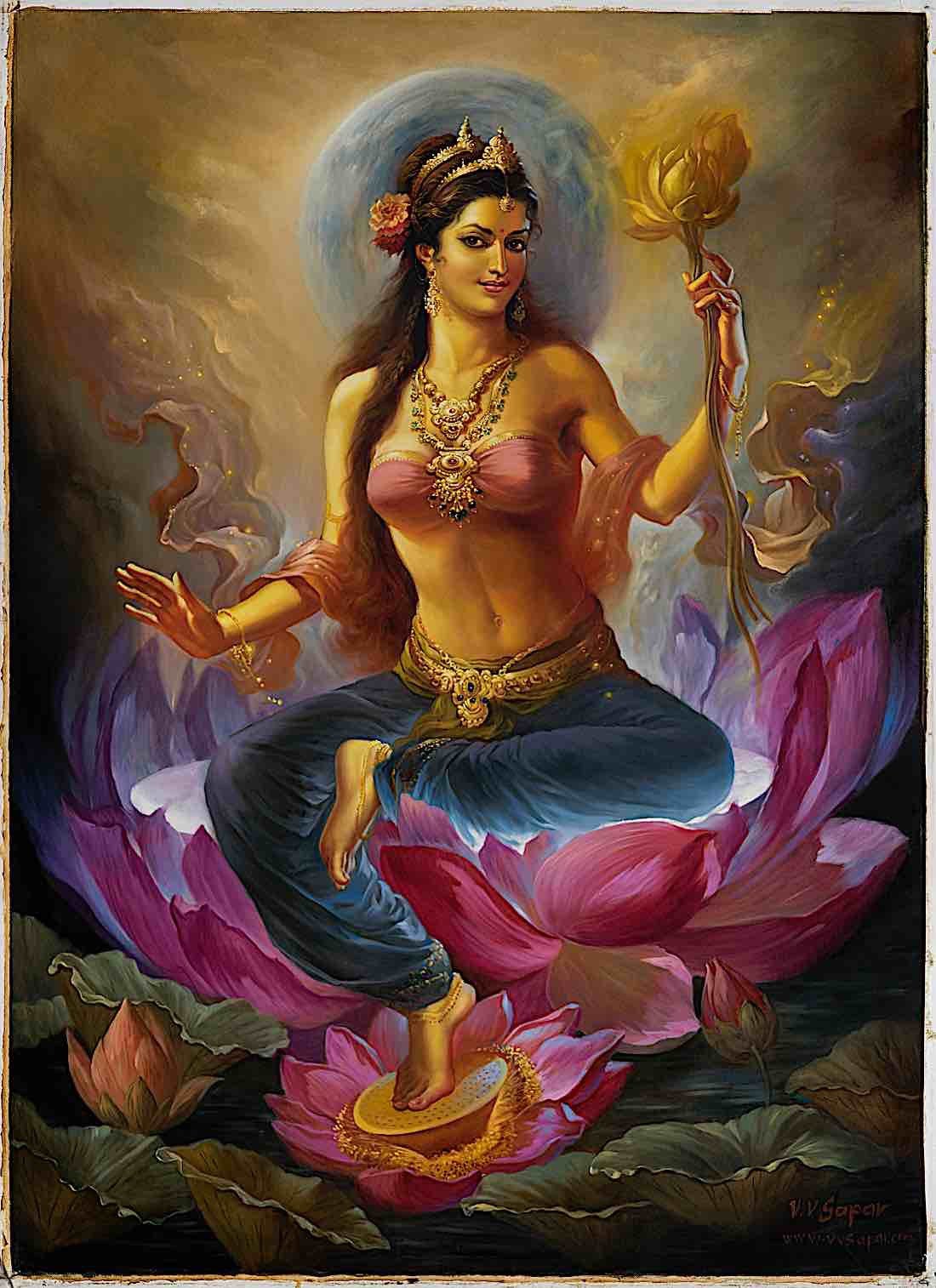
Attributes of Tara Proclaiming the Sound of HUM
- Power or Rite: subjugating.
- Seed syllable TA
- Colour: yellow
- Number of arms: two
- Peaceful or wrathful: peaceful
Mantra of Proclaiming the Sound of HUM
OM TARE TUTTARE TURE AKAR SHA YA HRI SOHA
For pronunciation, or to chant along, play the embedded video below.
Video of Proclaiming the Sound of Hum visualized with Tara’s first mantra chanted by Yoko Dharma:
Praise
Homage to you, who, uttering TUTTARE and HUM,
Fill the worlds of desire, direction, and space,
Who with your feet press down the seven worlds,
And who by your power draw all beings without exception.
Tara 6 Tara Victorious over the Three Levels of the World
Trai Lokya Vijaya Tara / Jig Ten Sum Lay Nam Par Gyal We Drolma

Attributes of Tara Victorious
- Power or Rite: purification of all obscurations and negativities.
- Seed syllable RE
- Colour: ruby red
- Number of arms: four
- Peaceful or wrathful: peaceful
Mantra of Tara Victorious
OM TARE TUTTARE TURE SARVA BE GHAN NA SHA TRUM UTSA TRA YA SOHA
For pronunciation, or to chant along, play the embedded video below.
Video of Tara Victorious over the Three Levels of Worlds visualized with Tara’s first mantra chanted by Yoko Dharma:
Praise
Homage to you to whom Indra, Agni,
Brahma, Vayu, Ishvara and the other gods offer prayers,
And who are praised by spirits, zombies,
Smell eaters and Yakshas.
Tara 7 Tara Who Crushes Adversaries
Vadi Pramardani Tara / Golwa Jompi Drolma

Attributes of Tara Who Crushes Adversaries
- Power or Rite: The transference of consciousness to the Akanistha Pureland at time of death; destroyer of adversaries.
- Seed syllable TU
- Colour: ruby black
- Number of arms: four
- Peaceful or wrathful: wrathful
Mantra of Tara Who Crushes Adversaries
OM TARE TUTTARE TURE SARVA BEYA AVA RA NAM YE SOHA
For pronunciation, or to chant along, play the embedded video below.
Video of Tara Who Crushes Adversaries visualized with Tara’s first mantra chanted by Yoko Dharma:
Praise of Tara Who Crushes Adversaries
Homage to you who with the mantras TRA and PHAT
Completely destroy all the magic wheels,
Crushing them with your right leg bent and your left stretched out,
Burning them completely in a blazing whirl of fire.
For the full Praise — the same praise for any system of 21 Taras — see below with both Sanskrit and English Translated versions. Many teachers recommend this as a daily chant/meditation.
For those looking for the book details referenced above:
Book Details
- Paperback: 176 pages
- Publisher: Wind Horse Press (January 3, 2013)
- Language: English
- ISBN-10: 0992055407
- ISBN-13: 978-0992055400
21 Praises
Around the world, many people begin and end their day with Tara’s twenty-one praises. This practice has been credited with many benefits, including protection from harm, prosperity, and swift progress on the path of enlightenment.
It can be beneficial to chant this in the world’s oldest known language—Sanskrit. The nuances of this practice, the originating sounds, is similar to mantra practice. In Sanskrit:
Om namah spukasam namah Taraye mi Tara
1 Namas Tare Ture vire
kshanair dyuti nibhekshane
trailokya nat ha vaktrabja
vikasat kesharobhave
2 Namah shata sharac chandra
sampurna patalanane
Tara sahasra nikara
prahasat kira noj jvale
3 Namah kanaka nilabja
pani padma vibhu shite
dana virya tapah shanti
titik sha dhyana gochare
4 Namas tat hagatosh nisha
vijayananta charini
ashesha paramita prapta
jina putra nishevite
5 Namas Tuttara Hum kara
puritasha dig antare
sapta loka kramakranti
asheshak arshanak shame
6 Namah shakranala Brahma
marud vishvesh varachite
bhuta vetala gand harva
gana yaksha puras krte
7 Namas trad iti phat kara
para yantra pramardani
praty alid ha pada nyase
shik hi jvalakulek shane
8 Namas Ture maha ghore
mara vira vinashani
bhrku ti krta vaktrabja
sarva shatrum nishudani
9 Namas tri ratna mudranka
hrdyanguli vibhushite
bhu shitashesha dik chakra
nikara sva Karakule
10 Namah pramudita topa
muku ta kshipta malini
hasat prahasat Tuttare
mara loka vashamkari
11 Namah samanta bhu pala
patalakarshana kshame
chalat bhrku ti hum kara
sarvapada vimoch ani
12 Namah shikhanda kandendu
muku tabha ranojjvale
Amitabha jata bhara
bhasvare kirana dhruve
13 Namah kalpanta hutabhug
jvala malan Tara sthite
alidha muditabandha
ripu chakra vinashani
14 Namah kara talaghata
charana hata bhu tale
bhrkuti krta Hum kara
sapta patala bhedini
15 Namah shive shubhe shante
shanta nirvana gochare
svaha pranava samyukte
maha papaka na shani
16 Namah pramudi tabandha
ripu gatra vabhedini
dashakshara pada nyashe
vidya Hum kara dipite
17 Namas Ture pada ghata
Hum karakara bijite
meru mandara kailasa
bhuvana traya chalini
18 Namah sura sarakara
harinika karast hite
Tara dvir ukta Phat kara
ashesha visha nashani
19 Namah sura ganadh yaksha
sura kimnara sevite
abandha mudita bhoga
kali duhs vapna nashani
20 Namah chandrarka sampurna
nayana dyuti bhas vare
hara dvir ukta Tuttare
vishama jvara nashani
21 Namas tri tattva vinyasa
shiva shakti saman vite
graha vetala yakshaugha
nashani pravare Ture
21 Praises to Tara in English
The praises do lose some of the “mystery” and intensity and sheer sound-power in English, but the intention and praise is maintained. Many people chant the praise in English:
1 Homage to you, Tara, the swift heroine,
Whose eyes are like an instant flash of lightning,
Whose water-born face arises from the blooming lotus
Of Avalokiteshvara, protector of the three worlds.
2 Homage to you, Tara, whose face is like
One hundred full autumn moons gathered together,
Blazing with the expanding light
Of a thousand stars assembled.
3 Homage to you, Tara, born from a golden-blue lotus,
Whose hands are beautifully adorned with lotus flowers,
You who are the embodiment of giving, joyous effort, asceticism,
Pacification, patience, concentration, and all objects of practice.
4 Homage to you, Tara, the crown pinnacle of those thus gone,
Whose deeds overcome infinite evils,
Who have attained transcendent perfections without exception,
And upon whom the sons of the Victorious Ones rely.
5 Homage to you, Tara, who with the letters TUTTARA and HUM
Fill the (realms of) desire, direction, and space,
Whose feet trample on the seven worlds,
And who are able to draw all beings to you.
6 Homage to you, Tara, venerated by Indra,
Agni, Brahma, Vayu, and Ishvara,
And praised by the assembly of spirits,
raised corpses, Gandharvas, and all yakshas.
7 Homage to you, Tara, whose TRAT and PHAT
Destroy entirely the magical wheels of others.
With your right leg bent and left outstretched and pressing,
You burn intensely within a whirl of fire.
8 Homage to you, Tara, the great fearful one,
Whose letter TURE destroys the mighty demons completely,
Who with a wrathful expression on your water-born face
Slay all enemies without an exception.
9 Homage to you, Tara, whose fingers adorn your heart
With the gesture of the sublime precious three;
Adorned with a wheel striking all directions without exception
With the totality of your own rays of light.
10 Homage to you, Tara, whose radiant crown ornament,
Joyful and magnificent, extends a garland of light,
And who, by your laughter of TUTTARA,
Conquer the demons and all of the worlds.
11 Homage to you, Tara, who are able to invoke
The entire assembly of local protectors,
Whose wrathful expression fiercely shakes,
Rescuing the impoverished through the letter HUM.
12 Homage to you, Tara, whose crown is adorned
With the crescent moon, wearing ornaments exceedingly bright;
From your hair knot the buddha Amitabha
Radiates eternally with great beams of light.
13 Homage to you, Tara, who dwell within a blazing garland
That resembles the fire at the end of this world age;
Surrounded by joy, you sit with your right leg extended
And left withdrawn, completely destroying all the masses of enemies.
14 Homage to you, Tara, with hand on the ground by your side,
Pressing your heel and stamping your foot on the earth;
With a wrathful glance from your eyes you subdue
All seven levels through the syllable HUM.
15 Homage to you, Tara, O happy, virtuous, and peaceful one,
The very object of practice, passed beyond sorrow.
You are perfectly endowed with SOHA and OM,
Overcoming completely all the great evils.
16 Homage to you, Tara, surrounded by the joyous ones,
You completely subdue the bodies of all enemies;
Your speech is adorned with the ten syllables,
And you rescue all through the knowledge-letter HUM.
17 Homage to you, Tara, stamping your feet and proclaiming TURE.
Your seed-syllable itself in the aspect of HUM
Causes Meru, Mandhara, and the Vindhya mountains
And all the three worlds to tremble and shake.
18 Homage to you, Tara, who hold in your hand
The hare-marked moon like the celestial ocean.
By uttering TARA twice and the letter PHAT
You dispel all poisons without an exception.
19 Homage to you, Tara, upon whom the kings of the assembled gods,
The gods themselves, and all kinnaras rely;
Whose magnificent armor gives joy to all,
You who dispel all disputes and bad dreams.
20 Homage to you, Tara, whose two eyes – the sun and the moon –
Radiate an excellent, illuminating light;
By uttering HARA twice and TUTTARA,
You dispel all violent epidemic disease.
21 Homage to you, Tara, adorned by the three suchnesses,
Perfectly endowed with the power of serenity,
You who destroy the host of evil spirits, raised corpses, and yakshas,
O TURE, most excellent and sublime!
- For Part 2 in this series see>>
- For Part 3 in this series see>>
- For Surya Gupta Art feature and interview with artists Angeli Lhadripa Shkonda on Buddha Weekly, see>>
- For a feature interview with master artist V.V. Sapar in Buddha Weekly, see>>
NOTES
[1] Tara in the Palm of Your Hand, by Venerable Zasep Rinpoche, page 28.
[2] Ibid, page 36
[3] Ibid, page 66
[4] ibid, page 75
More articles by this author
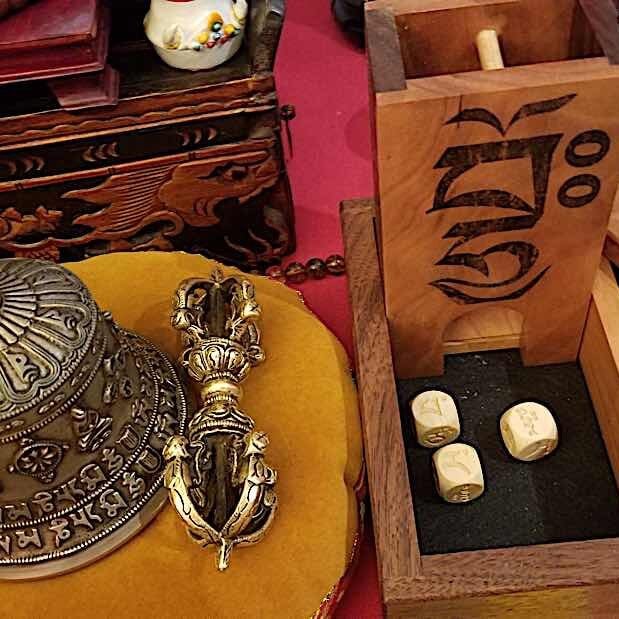
Mo Dice and Mo Mala, Bamboo Sticks, and other “divinations” — “Mo could prove beneficial…” HH Sakya Trizin
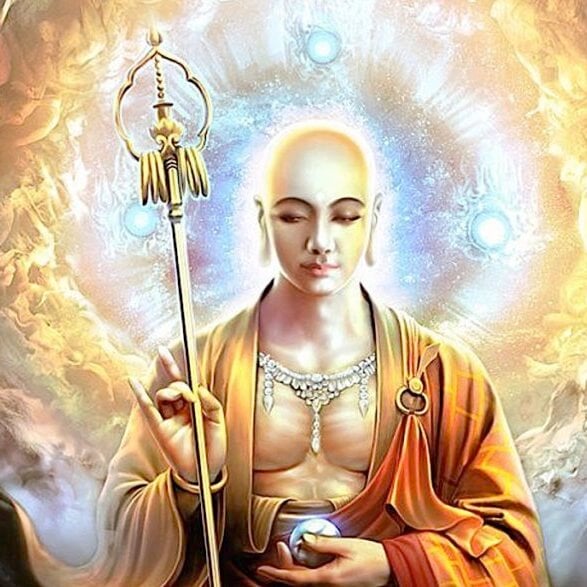
Lama Zopa Rinpoche and other teachers recommend Kṣitigarbha mantra and practice for times of disaster, especially hurricane and earthquake, because of the great Bodhisattva’s vow

Profound simplicity of “Amituofo”: why Nianfo or Nembutsu is a deep, complete practice with innumerable benefits and cannot be dismissed as faith-based: w. full Amitabha Sutra
Search
Latest Features
Please support the "Spread the Dharma" mission as one of our heroic Dharma Supporting Members, or with a one-time donation.
Please Help Support the “Spread the Dharma” Mission!

Be a part of the noble mission as a supporting member or a patron, or a volunteer contributor of content.
The power of Dharma to help sentient beings, in part, lies in ensuring access to Buddha’s precious Dharma — the mission of Buddha Weekly. We can’t do it without you!
A non-profit association since 2007, Buddha Weekly published many feature articles, videos, and, podcasts. Please consider supporting the mission to preserve and “Spread the Dharma." Your support as either a patron or a supporting member helps defray the high costs of producing quality Dharma content. Thank you! Learn more here, or become one of our super karma heroes on Patreon.
Josephine Nolan
Author | Buddha Weekly
Josephine Nolan is an editor and contributing feature writer for several online publications, including EDI Weekly and Buddha Weekly.






